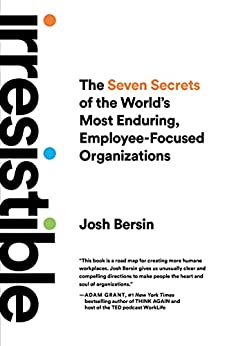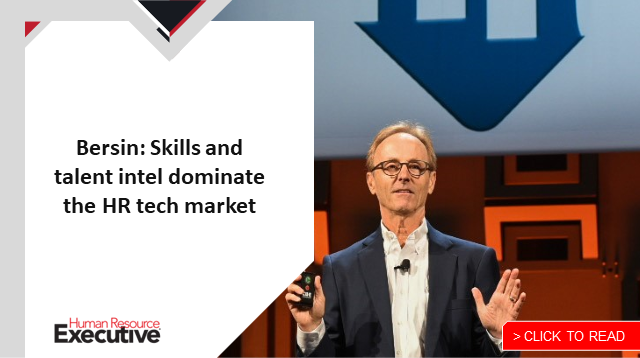Note: The practices described in my new book, Irresistible: The Seven Secrets of the World’s Most Enduring, Employee-Focused Organizations, are distilled from years of research into workforce trends and the HR practices that have the biggest business impact. To factor in employee sentiment, I also dug through years of Glassdoor data to find companies with consistently high scores. I found that these top-rated companies have three things in common: the ability to survive and thrive throughout good and bad business cycles and market shifts; sustained profitability over time; and the creation of respected, enduring market brands. In other words, they are “irresistible” to employees, customers and shareholders.
I truly believe we, as HR professionals, have the power to help our organizations thrive, grow and inspire people. My hope is that the seven practices summarized in this book will make work more productive, fulfilling, and even fun for you, your teams and your company.
Here is an excerpt from the book:
First, let me define what “irresistible” means and how I came up with the term.
As I studied HR and talent management over the decades, I realized that measuring employee engagement was not sufficient. Most companies have happy employees while they’re growing, but then, when they slow, engagement drops quickly.
 What we really want to evaluate is what I call “organizational endurance”—the ability of companies to be irresistible today and long into the future. This means building an organization that has the management muscle to grow, change, flex, and adapt, all with a focus on purpose, mission, and values.
What we really want to evaluate is what I call “organizational endurance”—the ability of companies to be irresistible today and long into the future. This means building an organization that has the management muscle to grow, change, flex, and adapt, all with a focus on purpose, mission, and values.
As I’ve met with many CEOs and CHROs over the years and discussed these issues with many employee engagement companies, I’ve come to the conclusion that there are really four things to consider.
MISSION
Does the company have an enduring mission or purpose, one that sur- vives generational change? Johnson & Johnson, for example, is built on a credo to take care of the doctors, nurses, patients, and mothers that use their products. It was developed and chiseled into the wall of its New Jersey headquarters in 1943. It goes beyond responsibility to customers; it also describes the company’s responsibility to employees, communities, and shareholders.
IKEA is built on a mission to “create a better everyday life” with well-designed home furnishings at low prices so as many people as possible can afford them. IKEA also cares about its responsibility to the environment, to a sustainable planet, and to its communities.
Patagonia often calls itself “a cause, disguised as a company.” The CEO and founder Yvon Chouinard actually believes he is in business to save the planet. Starting as a company that made tools for climbers, the organization still focuses on building products that cause the least harm to nature, with products that endure for decades.
I’ve worked for many companies that lost their mission, and in the pro- cess, they often lose their irresistible status. Some organizations falter and regain their balance. Microsoft, for example, spent many years driven by the mission to democratize computing through its software. But then it chased the internet, mobile, and other trends and lost its way. Now, the company has come back home, with a mission of empowering people and organizations through its products.
 I could go on and on about mission, but suffice to say that it’s the guiding light illuminating the clear path forward.
I could go on and on about mission, but suffice to say that it’s the guiding light illuminating the clear path forward.
PRODUCTIVITY
As I’ve studied employee engagement over the years, I always noticed something interesting: the companies with the most engaged employees also seem to be growing the fastest. They are clear on their goals, they understand their market, and they get things done.
As I dug into the issue, I figured out why.
These companies don’t just think about making their employees happy; they think about helping employees stay productive. They design their organizations, their rewards, and their managerial strategies around how to get work done.
Irresistible companies, those often in the top 10 percent of the Glassdoor database, have terrific financial results. In fact, as I analyzed the data, I found that these excellent companies are more than twice as likely to be rated fast-growing, with the vast majority citing strong business growth, compared to less than half for the entire sample.
While the word “productivity” has a somewhat cold, economic feeling, it’s really an important topic. Research by Teresa Amabile in The Progress Principle found after studying the work logs of thousands of employees that the most rewarding thing at work is “getting something done.” People really enjoy helping others, pushing their projects forward, and completing activities. The key is to make these experiences efficient and meaningful.
Research I conducted a few years ago with LinkedIn found that the single thing that inspires people to work the hardest is “the nature of the work itself.” When people like their jobs and they feel they can progress in their careers, they are happy.
On the whole, however, productivity has been a big issue over the last decade. And, in many ways, this problem is one of the reasons I wrote this book.
Here’s the issue: productivity is generally defined as output per hour of work (or dollar of labor). As we transition to the digital economy, global productivity has been slowing, and not just because of the pandemic. This is a serious economic problem. Productivity is the engine that fuels wage growth, employment, and business sustainability. Despite the enormous amount of automation we see at work, we have not yet found a way to effectively adapt to this change.
Some economists blame the aging population. Others cite the younger population. Many point to the lack of infrastructure investment. (Commute times have gone up by almost an hour a day in the last 10 years.) Some even think the measurement system is wrong.
My experience shows it’s something different: the digital world of work requires that we rethink how organizations operate. This lowered productivity is a symptom of companies struggling to adapt. While new technology and tools proliferate and are incessant, we are still doing work the traditional way. We need to adopt the seven practices in this book to make productivity skyrocket.
Lagging productivity and employee engagement are not problems; they are symptoms of a fundamental change in business. The way we add value has changed. Companies no longer add value through scale and efficiency; they add value through innovation, invention, and service. This means we have to run companies differently.
As I’ve discovered in my travels around the world, high-performing companies organize, manage, and structure themselves differently. In embracing these changes, we will see productivity (and engagement and happiness) go up in ways we’ve never seen before—provided we undertake the seven innovations detailed in this book.
ENGAGEMENT
Human resources managers use the term “engagement” to define how well our companies operate. According to many sources, typically around one-third of employees are fully engaged at work. Gallup, the polling organization that developed the first employee-engagement survey, just released its 2021 findings and found that engagement increased to 39 percent, up from 36 percent in late 2020.
We’re going in the right direction overall, but while many companies are well above average, many are well below. Irresistible companies, I’ve learned over the years, generally rank at the top of engagement surveys. The only pattern I’ve seen among these companies is the quality and focus of their management. They are focused on their people, they understand that people are their product, and they continuously invest, re-engineer, and focus on management practices that empower people.
The engagement industry is a billion-dollar marketplace of consultants, tools, books, workshops, and events focused on this topic. In fact, the terms “organizational culture” and “employee engagement” have become such catchphrases that companies can compete in dozens of nationwide companies for a best-place-to-work title.
 Engagement is a good topic. But ultimately, as I’ve discovered, the solution is more than just conducting surveys. It requires a fundamental focus on management and people, a true understanding that each individual matters, and a plan for how to build a company around engagement goals.
Engagement is a good topic. But ultimately, as I’ve discovered, the solution is more than just conducting surveys. It requires a fundamental focus on management and people, a true understanding that each individual matters, and a plan for how to build a company around engagement goals.
Not long ago, I met with the senior executives at Genentech, which rates as one of the most engaged and irresistible places to work. The CEO of Genentech believes so strongly in people, he tells his scientists and staff that “mission trumps profits” and that if you’re not helping make society healthier, you’re not working on the right thing. Genentech is doing everything in its power to remove complexity, increase productivity, and elevate the employee experience. This is what irresistible companies do.
Irresistible companies, which are growing far faster than their peers, have a unique ability to focus on their people first. They endure during good times and bad. This employee-first focus will become clear and actionable as you read the seven innovations in this book.
HAPPINESS
Happiness is the essential human mood that brings us to work ready to help, contribute, and innovate. This measure is plummeting at an alarming rate.
Funded by the Organisation for Economic Co-operation and Development, the World Happiness Report looks at data from more than 100 countries. In 2020, a slightly smaller number of countries were surveyed because of the pandemic, but the findings were similar: the world’s happiest countries are Finland, Denmark, Switzerland, Iceland, the Netherlands, Norway, Sweden, Luxembourg, New Zealand, and Austria. The United States, which has previously ranked as the 13th happiest place in the world, slipped from 18th to 19th place in 2020.
Why is this going on, and what can we as business leaders do about it? The three issues at stake here are trust, fairness, and social cohesion.
Trust is definitely down. In the 2020 Edelman Trust Index, the majority of respondents made it clear that they expect businesses to speak out against issues like systemic racism, to make products that don’t harm the environment, and to help the world reduce greenhouse gases. Seven in ten respondents said that trusting a brand to take such actions is more important now than in the past. We as businesspeople must ensure that our business leaders and managers heed these societal demands.
The second happiness issue is fairness. Today, income inequality is becoming a crisis. The Gini index, which describes the level of wealth disparity in a given country (a Gini of 1.0 means one person has all the wealth in society, and a Gini of 0 means everyone has exactly the same level of wealth), is skyrocketing. According to the 2021 Gini index, the gap between the richest and poorest has never been wider.
 Even though the employment rate continues to rise and the stock market is high, our cities are filled with unhoused people. The end of 2020 brought the sharpest rise in the U.S. poverty rate since the 1960s; one in seven Americans now has annual family resources below the poverty threshold, with 4.4 percent described by the Urban Institute as being mired in deep poverty.
Even though the employment rate continues to rise and the stock market is high, our cities are filled with unhoused people. The end of 2020 brought the sharpest rise in the U.S. poverty rate since the 1960s; one in seven Americans now has annual family resources below the poverty threshold, with 4.4 percent described by the Urban Institute as being mired in deep poverty.
Many surveys of Millennials in developed economies suggest that they believe they will be “less well off” and “less happy” than their parents. They see property prices going up as wages stay flat, and they take gig jobs to make more money. They believe the world has become unfair. We can certainly address this in our management practices, but this is why diversity, inclusion, pay equity, and transparency have become paramount.
The third issue is social cohesion. As Robert D. Putnam discusses in his iconic book Bowling Alone, we live in larger homes, are more separated from our neighbors, and are spending more time on our cell phones. We have fewer friends, and we don’t have as many close relationships.
I’m not going to turn this book into a political manifesto, but I will tell you this: we, as business leaders, can and must fix this. We can create a sense of trust in our companies and a sense of social cohesion if we just manage our companies better.
To purchase a copy of the book, visit this link.
The post Josh Bersin book excerpt: How HR can help orgs ‘thrive, grow and inspire’ appeared first on HR Executive.